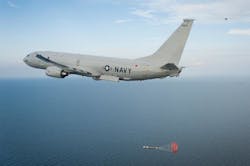Boeing looks into installing MUOS SATCOM system to improve communications aboard P-8A reconnaissance plane
PATUXENT RIVER NAS, Md. – U.S. Navy aerial surveillance experts are asking the Boeing Co. to determine the feasibility of integrating the new Mobile User Objective System (MUOS) satellite communications (SATCOM) system aboard the P-8A Poseidon maritime patrol aircraft.
Officials of the Naval Air Systems Command at Patuxent River Naval Air Station, Md., announced their intention on Tuesday to award a sole-source deliver order to the Boeing Defense, Space & Security segment in Seattle to investigate MUOS integration aboard the P-8.
The value of the upcoming contract to Boeing has yet to be negotiated. Contract award is expected in early 2021.
MUOS is a UHF communications system that operates at frequencies from 300 MHz to 3 GHz and will replace the legacy UHF Follow-On (UFO) system before that system reaches its end of life. MUOS is intended to provide mobile users with new capabilities and enhanced mobility, access, capacity, and quality of service.
Boeing, the P-8 designer, will conduct a technical study to determine the feasibility of installing MUOS capability on dual SATCOM channels on the P-8A, while maintaining legacy voice, Link-11, and DAMA/DAMA-IW SATCOM with the current UHF 5 and UHF 6 radio suite on the P-8.
Boeing also will determine if the Multifunctional Information Distribution System (MIDS) Tactical Air Navigation System (TACAN) would be compatible with a MUOS installation aboard the P-8A.
The MUOS operates as a global cellular service provider to support the warfighter with modern cell phone-like capabilities such as multimedia.
It converts a commercial 3G wideband code division multiple access (WCDMA) cellular phone system to a military UHF SATCOM radio system using geosynchronous satellites in place of cell towers. Operating in UHF enables warfighters to communicate in difficult areas like forests where trees could attenuate relatively high-frequency signals.
The P-8A is a militarized version of the Boeing 737 single-aisle jetliner hardened for long-range maritime patrol and anti-submarine warfare (ASW) missions. The P-8 is replacing the Lockheed Martin P-3 Orion maritime patrol turboprop aircraft.
Ultimately, the Navy plans to buy 108 P-8A aircraft from Boeing to replace the service’s fleet of 196 P-3C Orion maritime patrol aircraft, which are approaching the end of operational life. The P-3 is a version of the Lockheed Martin Electra four-engine turboprop aircraft.
The P-8A can fly at extremely low altitudes over the ocean during close-in searches for potentially hostile submarines. The P-8A is designed to withstand the rigors of low-altitude turbulence and exposure to salt spray.
Navy officials plan to use the P-8A in tandem with the Northrop Grumman RQ-4N Triton Broad Area Maritime Surveillance (BAMS) unmanned aerial vehicle (UAV) -- a maritime-patrol version of the Global Hawk long-range surveillance UAV.
Plans call for using the P-8A from relatively high altitudes to detect potentially hostile submarines and surface ships, and upon detection, to call in the BAMS UAV to take a closer look. The P-8A also can attack hostile vessels with torpedoes and missiles.
Boeing is building the Poseidon aircraft at its factory in Renton, Wash. The plane's flight management system and the stores management system have been developed by GE Aviation Systems in Grand Rapids, Mich. The cabin has as many as seven operator consoles.
The Poseidon’s MX-20HD digital electro-optical and infrared (EO/IR) multi-spectral sensor turrets come from L-3 Communications Wescam in Burlington, Ontario. The MX-20HD is gyro-stabilized and can have as many as seven sensors, including infrared, CCDTV, image intensifier, laser rangefinder, and laser illuminator.
The aircraft has the upgraded APS-137D(V)5 maritime surveillance radar and signals intelligence (SIGINT) system from the Raytheon Technologies Corp. Intelligence & Space segment in McKinney, Texas.
The APS-137D(V)5 radar, which is installed on the P-8’s enlarged nose fairing, provides synthetic aperture radar (SAR) for imaging stationary ships and small vessels, coastal and overland surveillance, and high-resolution imaging synthetic aperture radar (ISAR) for imaging surfaced submarines and fast surface vessels operating in coastal waters.
The P-8A will have the CAE Inc. advanced integrated magnetic anomaly detection (MAD) system. The Navy plans to arm the P-8A with the MK 54 torpedo.
For more information contact Boeing Defense, Space & Security online at www.boeing.com, or Naval Air Systems Command at www.navair.navy.mil.
About the Author
John Keller
Editor-in-Chief
John Keller is the Editor-in-Chief, Military & Aerospace Electronics Magazine--provides extensive coverage and analysis of enabling electronics and optoelectronic technologies in military, space and commercial aviation applications. John has been a member of the Military & Aerospace Electronics staff since 1989 and chief editor since 1995.
